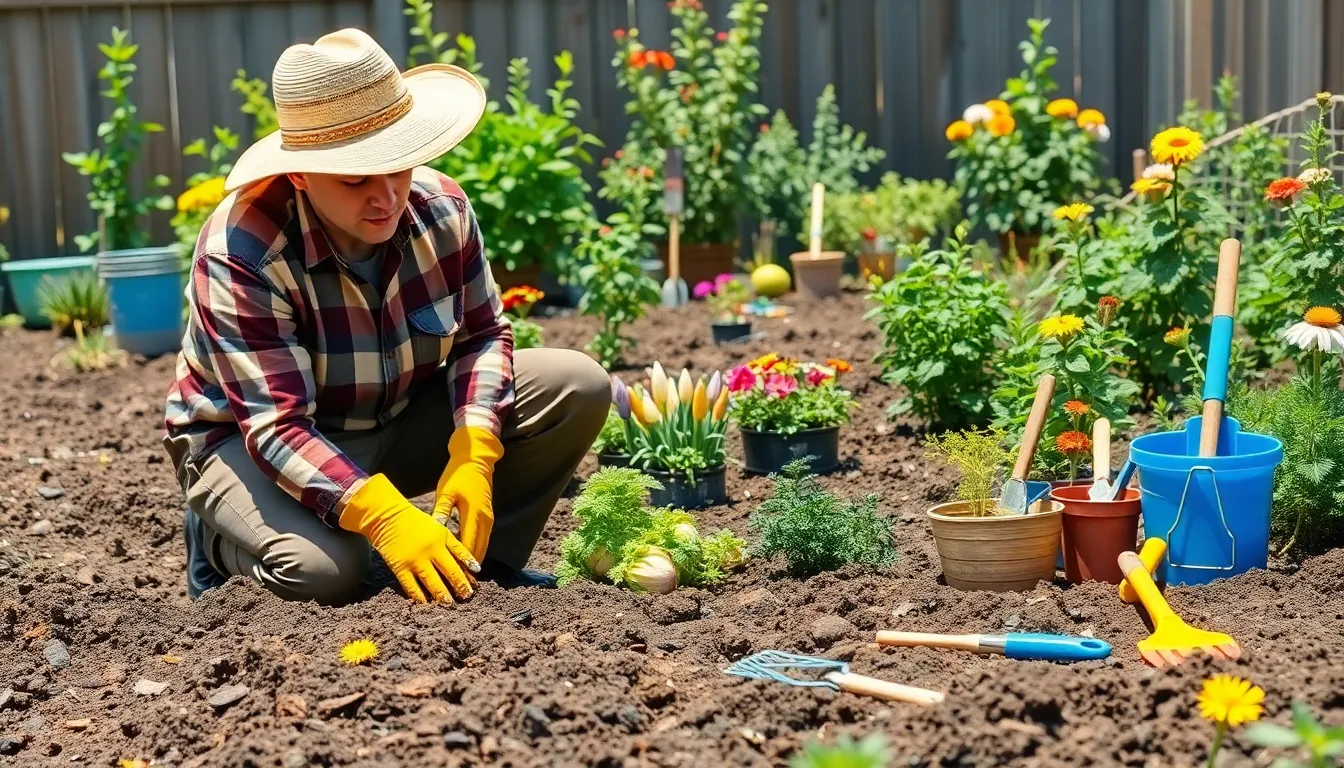Gardening isn’t just for those with a green thumb; it’s for anyone ready to dig in and get their hands a little dirty. Whether you’re a seasoned pro or just starting out, having the right tools can turn a patch of dirt into a flourishing paradise—or at least a place where plants don’t immediately meet their demise.
Gardening Essentials
Gardening relies on specific tools and supplies to create a flourishing environment. Knowing the essentials simplifies the process for anyone looking to cultivate their green space.
Tools You Need
Basic garden tools include a spade, trowel, and pruning shears. A garden fork helps cultivate soil and aerate compacted areas. Gloves protect hands while working with soil and plants. Secateurs offer precision for trimming plants and branches. Rakes assist in clearing debris and leveling soil. Watering cans or hoses ensure proper hydration of plants. Tool storage solutions keep these essentials organized for easy access.
Essential Supplies
Quality soil serves as the foundation for healthy plants. Amendments like compost enhance nutrient content and improve soil structure. Fertilizers provide necessary nutrients for plant growth, while mulch retains moisture and suppresses weeds. Seed packets contain various plant options, from flowers to vegetables, enabling diverse gardening projects. Labels help track plant types and care instructions, ensuring proper attention during growth. Pest control measures protect plants from harmful insects and diseases.
Preparing Your Garden

Preparing your garden establishes a solid foundation for successful growth. Effective preparation involves focusing on soil and selecting the right plants.
Soil Preparation
Soil quality significantly impacts plant health. Begin by testing the soil to assess pH and nutrient levels. Amendments like compost can enhance soil fertility, whereas sand improves drainage. Till the soil to a depth of at least 12 inches, breaking up clumps to ensure a loose texture. Incorporate organic matter to boost microbial activity, leading to healthier plants. Furthermore, consider the specific needs of your plants while enriching the soil, tailoring additions for optimal results.
Plant Selection
Choosing the right plants ensures a vibrant and thriving garden. Evaluate the climate, sunlight, and soil conditions in your area first. Perennials, annuals, and vegetables each serve different purposes and environments. Select native plants for low maintenance and resilience against local pests. Further, consider seasonal blooms for continual color throughout the year. Finally, grouping plants by their water and sunlight needs simplifies care and promotes healthy growth.
Maintenance Tips
Maintaining a garden requires consistent effort and knowledge of best practices. Focusing on watering and fertilization significantly enhances plant health and growth.
Watering Techniques
Effective watering techniques ensure plants receive sufficient moisture. Applying water in the early morning reduces evaporation and allows for maximum absorption. Utilizing a soaker hose or drip irrigation system delivers water directly to the roots, minimizing waste. Adjusting watering frequency depends on plant type and weather conditions. Observing plants for signs of wilting or drooping can guide hydration needs. Determining soil moisture by checking the top inch can help avoid overwatering.
Fertilization Basics
Understanding fertilization basics is crucial for plant vitality. Choosing a balanced fertilizer provides essential nutrients for robust growth. Applying fertilizer during the growing season promotes healthy foliage and blooming. Timing the application according to plant needs, such as before spring growth, maximizes effectiveness. Incorporating organic compost improves soil structure and nutrient content. Monitoring plant response to fertilization allows for adjustments in future applications.
Troubleshooting Common Issues
Every gardener encounters challenges. Addressing these common concerns helps maintain a healthy garden.
Pest Management
Identifying pests promptly is crucial for effective control. Inspect plants regularly for visible signs of infestation, such as holes in leaves or sticky residue. Utilizing organic solutions like neem oil or insecticidal soap can minimize damage while being safe for beneficial insects. Introducing natural predators, such as ladybugs or lacewings, offers an excellent way to balance the ecosystem. Applying companion planting strategies also deters pests. For instance, marigolds planted alongside vegetables repel nematodes. Monitoring progress ensures that pest management strategies remain effective over time.
Weeding Strategies
Weeds compete with garden plants for nutrients and sunlight. Utilizing mulch acts as a barrier that prevents weed growth while retaining soil moisture. Hand-pulling weeds is effective, especially when done after rain, which softens the soil. Implementing a regular weeding schedule prevents infestations from taking root. Using a hoe allows for quick removal of surface-level weeds, ensuring a clean garden bed. Additionally, applying pre-emergent herbicides can prevent weed seeds from sprouting. Adopting these strategies fosters a thriving garden and limits work later in the season.
Conclusion
Gardening offers a rewarding experience that anyone can enjoy with the right approach. By equipping oneself with essential tools and supplies, it’s possible to create a vibrant green space that thrives. Proper preparation and maintenance are key to achieving success and ensuring plants flourish.
Understanding the unique needs of each plant and implementing effective care strategies can simplify the gardening journey. With patience and dedication, anyone can transform their garden into a beautiful sanctuary. Embracing these fundamentals will not only enhance the gardening experience but also contribute to a sustainable and healthy environment.

